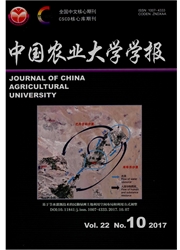

 中文摘要:
中文摘要:
为了确定硝态氮对饲料含氮量的杜马斯燃烧法测定值(Cn)和凯氏法测定值(Kn)的影响,对14种硝态氮含量较高的饲料原料,采用杜马斯燃烧法和凯氏法测定各样本中的含氮量,并以化学法测定硝态氮含量为对照进行分析。结果表明:14种样本含氮量的燃烧法测定值显著高于凯氏法测定值(P〈0.01),虽然2种方法测定结果间高度相关(r=0.9960),但拟合曲线与Y=X存在显著差异(P〈0.01),燃烧法与凯氏法测定值间差值(Cn-Kn)与饲料中硝态氮含量相关性低(R2=0.6036)。由此可得出,当饲料中含有大量硝态氮时,燃烧法测定值显著高于凯氏法测定值,但2种方法测定值差与硝态氮含量相关性低,因此硝态氮是造成饲料含氮量的燃烧法与凯氏法测定值间差异的原因之一,但不是惟一原因。
 英文摘要:
英文摘要:
This study was conducted to evaluate the effect of nitrate nitrogen (NO3-N) on the nitrogen content determined by Combustion( Rapid N Ⅲ, Elementar,Germany) and Kjeldahl (Foss Model 2300, Sweden) methods based on measurement of nitrogen (N) content and NO3-N content in 14 ruminant feedstuffs. The results showed that higher N content was obtained using the Combustion method compared with the Kjeldahl method (P 〈 0.01). Although there was a linear correlation (r = 0.9960) of N contents between the two determination methods, the slope of the regression equation was significantly (P 〈 0.01) different from that of Y = X, the correlation coefficient of the NO3-N content and the value of "Cn-Kn" was low (R2 = 0.6036). In conclusion, the Combustion method was superior to the Kjeldahl method when the feedstuffs contain significant quantities of NO3-N. NO3-N alone could not account for the difference between the Combustion method and Kjeldahl method.
 同期刊论文项目
同期刊论文项目
 同项目期刊论文
同项目期刊论文
 期刊信息
期刊信息
